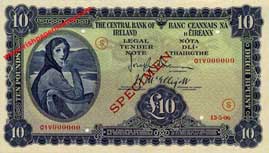
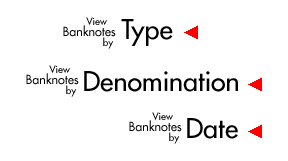
Page under active revision, last update 08.11.23
The A Series Legal Tender Note design circulated for 54 years, from 1928 to 1982, with the £100 note remaining in circulation for 67 years, until 1995. The design ranks with that of the US small size Federal Reserve Notes as one of the longest-lived banknote designs in daily circulation.
The A Series notes were replaced by the B Series progressively from 1976 to 1982. A design was developed for a B Series £100 note which was not proceeded with, and the A Series £100 note remained in use until it was replaced by a new design C Series £100 note in 1995.
Seven denominations were used: 10 Shillings, One Pound, Five Pounds, Ten Pounds, Twenty Pounds, Fifty Pounds, and One Hundred Pounds.
The board lists the current value of Irish 10 shilling notes to collectors.
In the 1920s a Banking Commission had been set up to consider the state of Irish currency. As a result of its final report recommendations, the Currency Act, 1927 [2] provided for the establishment of the Currency Commission Ireland and empowered it to issue, control and manage a new Irish currency, the Saorstat Pound, later termed the A Series Legal Tender Notes. Six of the nine Joint Stock commercial banks operating on the island of Ireland had the right to issue notes at the time and it was provided the currency notes in the country.
The new note issue was to ultimately replace the banknotes of the commercial Irish joint stock banks then in circulation throughout the country.
in parallel with the issue of the Legal Tender Notes in 1928, it was decided to create a separate issue of Consolidated Bank Notes (colloquially referred to as the Ploughman series) which would enter circulation on 6 May 1929 to facilitate the withdrawal of the existing banknotes of the joint stock banks which circulated throughout Ireland.
At the time of the creation of the Consolidated Bank Note Issue, the existing note issues of the commercial banks were also split between the Irish Free State and Northern Ireland. This splitting of the note issues is detailed on the page covering the Partition of Irish Currencies.
For stability, the Irish currency was linked to and exchangeable at par with the British Pound Sterling. The Irish Pound was divided into 20 shillings, and issued in seven denominations, 10 Shillings, £1, £5, £10, £20, £50, and £100.
The Irish Legal Tender Notes used a largely unchanged design from their creation in 1928 up to 1977. There are fourteen collectible Types, each represented by a change in signatory or an alteration in the design, or both.
Two major variations exist in the Issuing Authority title, the first being notes issued under the Currency Commission, 1928-1942 (Types 1-4); and the second being notes issued under the Central Bank of Ireland, 1943-1977 (Types 5-14).
Another major variation in design was the incorporation of a Special Identification Marking (SIM) 'War Code' into the design of the five lower denominations, up to £20, of banknotes produced during the Emergency period of World War 2. Banknotes bearing the SIM war code were issued under both Issuing Authorities, Type 4 (1940-1942), and Type 5 (1940-1942).
Prior to the creation of the Currency Commission in 1927, two of the joint stock banks which issued notes in the Irish Free State had produced completely new designs for all of their notes during a period of general redesign and modernisation of note issues in Ireland. The colours used in these new designs might have had an influence on the colours chosen for the new Irish Legal Tender Notes.
The Bank of Ireland and the National Bank had both completed the redesign of their entire note issue by 1922.
Bank of Ireland was using the following predominant colours on its 1922 series of banknotes: £1, green; £5, red; £10, blue; £20, orange; £50, purple; £100, brown.
The National Bank was using similar predominant colours on its 1919-1921 notes: £1, green; £5, brown; £10, red; £20, blue; £50, orange; £100, purple.
The choice of colours used for the Currency Commission Legal Tender Notes were broadly similar to those used on the new notes of the Bank of Ireland and the National Bank, with differing shades of green being used for the £1 note and the £100 note: 10 Shilling, orange; £1, green; £5, brown; £10, blue; £20, red; £50, purple; £100, green.
When approaching the choice of which denominations to include in the new Legal Tender Note series, the Currency Commission Ireland had a background of over a hundred years of stable currency circulation to consider.
Paper money in Ireland up to the 1920s had been provided almost exclusively by the Irish joint stock banks for the previous hundred years. All were privately owned companies. Prior to the 1820s, paper money had been provided by the Bank of Ireland, as the only joint stock bank, and by many Irish private banks.
Denominations issued by the banks in Ireland in the 1920s were £1, £5, £10, £20, £50, £100.
Irish banks had previously issued other denominations up to the early twentieth century, with Three Pounds being the only old fashioned denomination to continue in use into the 1900s.
Three Pounds was a denomination which is known to have been issued up to the First World War era, the last known date for a £3 note being 3 December 1915, issued by the National Bank.
Denominations of £500 were issued by Bank of Ireland in the latter half of the 19th century, and may have been issued up to around 1900 [BoI archives].
In addition, during the World War 1 era UK Treasury notes in denominations of 10 Shillings and One Pound were circulating in Ireland in place of Half Sovereigns and Sovereigns.
A great variety of fractional notes denominated in shillings, including 30 Shillings, were issued by the Irish private banks up to circa 1836, by which time the notes of private banks had been replaced by those of the joint stock banks.
In the earlier part of the 19th century the joint stock commercial banks issued denominations of 30 shillings, and 25 shillings, as well as 2 Pounds, and 4 Pounds. These denominations were phased out by the mid-1800s. Notes denominated in Guineas were also in use up to around 1820.
30 shillings was by far the most common of these denominations until it was discontinued following the Bankers (Ireland) Act 1845 [3] which prohibited all fractional denominations.
Interestingly, it appears that there were no Irish Ten Shilling notes ever issued by any bank.
The introduction of the ‘Lady Lavery’ Irish Legal Tender Note series in 1928 brought back a fractional denomination to Irish currency with the first ever issue of an Irish ten shilling note denomination, apart from the irregular production of Limerick Soviet notes in April 1919 during a general strike in Limerick city.
As fractional denominations had been prohibited by the Bankers (Ireland) Act, 1845, One Pound notes had been the lowest permissible denomination in circulation.
English Treasury Ten Shilling notes, issued to replace half sovereigns in circulation from 1914, would also have circulated in Ireland prior to the introduction of the Lavery Notes on 10 September 1928.
It may be that 10 shillings was found to be a useful denomination and that it was used in the Legal Tender Note series for that reason. It would have reduced the amount needed of the new Irish Coinage which was also introduced in 1928.
Additionally, the 10 Shilling denomination was in widespread use in other jurisdictions which used the Pound as a unit of currency.
Further research remains to be done on the background of the decision to include a Ten Shilling note as the lowest denomination of the new Legal Tender Note series.
The design of the A Series Legal Tender Notes were intended to have a strongly Celtic flavour, and to avoid any political symbolism. The Currency Commission had specified that an archetypal Irish Cailin (Girl) should form the central theme of the design of the notes.
She was, as Kathleen Ni Houlihan, to symbolise the Irish State, a type of symbol often used in the past. The banknotes were designed by Mr. John Harrison, the Chief Portrait Engraver of Waterlow and Sons Ltd, London, who were to print the notes.
A few years before this, Harrison had engraved a series of bookplates for Sir John Lavery, RA. One of these was a portrait by Lavery of his wife, Hazel, Lady Lavery. Harrison adapted this portrait for use on the banknotes. Lady Lavery is depicted in Irish national costume resting her arm on a Cláirseach (Irish Harp). Behind her in the background are lakes and mountains, typical of Ireland.
The full portrait is used on the £10, £20, £50, and £100 denominations, with a head and shoulders cut-off on the lower denominations.
Thus, the notes are colloquially referred to as the Lady Lavery series.
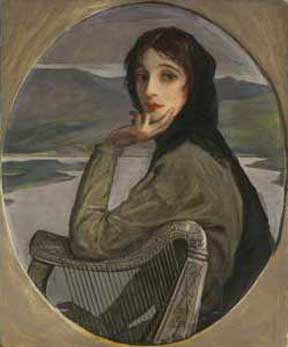
Image supplied by The Central Bank of Ireland
Above is the Portrait of Lady Lavery as Kathleen Ni Houlihan, 1928, by Sir John Lavery (1856-1941), Oil on canvas 75.5 x 62.5 cm. The painting is on loan from the Central Bank of Ireland to the National Gallery in Dublin, and is on public display there.
The portrait on the banknotes faces in the opposite direction to that in the original painting.
Type 1 to Type 4 (1928–1940), issuing authority Currency Commission Ireland
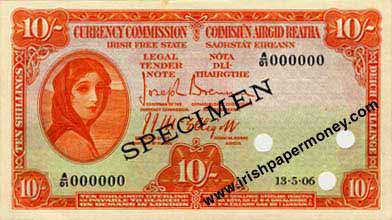
1928 Irish Ten Shilling Note specimen, Currency Commission Irish Free State, with fictitious date 13.5.06
Type 4 to Type 5 (1940–1944), Special Identification Marking war code security feature added to all denominations except £50 and £100.
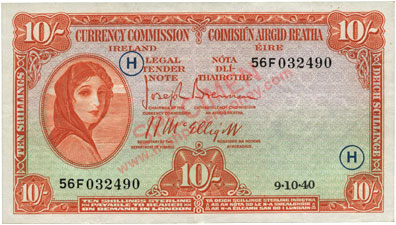
Currency Commission Ireland, 10 Shillings, dated 26 September1940, with war code letter H in field on top left and bottom right

From Type 11 (1961) Sterling Promise removed from notes, although the Irish currency continued to be linked on a par basis to Sterling.

1928–1960 Sterling Promise in the bottom panel of every Lady Lavery banknote.

1961–1977 Sterling promise replaced by denomination in words.
For the reverse of the Legal Tender Notes, Harrison used designs based on a selection from a series of fourteen stone sculptured masks representing the Atlantic Ocean and thirteen rivers of Ireland. The River Masks were sculpted in the eighteenth century by Edward Smith and adorn the facade of the Custom House, Dublin, one of Ireland’s most attractive buildings. The Custom House itself is the central feature on the reverse of the £1 'Ploughman' Consolidated banknote.
For the first four denominations, Ten Shillings through to Ten Pounds, the smile on the faces of the River Gods broadens with ascending value. This may or may not be intentional. From the Twenty Pound note upwards however, the faces maintain a more serious disposition.
The following River Masks were selected for the reverse of the banknotes [2. Moynihan 1975, p. 127]
10 Shillings: River Blackwater, wearing a headdress of a basket of apples on a carpet of fish.
£1: River Lee.
£5: River Lagan.
£10: River Bann, wearing a linen turban and river pearls.
£20: River Boyne. This one is interesting in that while the original mask on the Custom House appears with the date 1690 on its turban, commemorative of the Battle of the Boyne, this date is omitted on the banknote version.
£50: River Shannon.
£100: River Erne, displaying its eel fisheries on its headdress.
Dimensions are from actual measurement of notes, dated 10.9.28.
The dimensions tended to vary by up to several millimetres, depending on the cut. On some earlier notes, the cut has been seen quite off-square.
10 shilling Note, 138 x 78 mm
£1 Note, 151 x 84 mm
£5 Note, 165 x 92 mm
£10 Note, 191 x 108 mm
£20 Note, 203 x 114 mm
£50 Note, 203 x 114 mm
£100 Note, 203 x 114 mm
There are 231 dates for the Irish Ten Shilling note, from 10.9.28 to 6.6.68, and 257 dates for the Irish One Pound note, the last date being 30.9.76.
These two denominations made up the bulk of Currency Commission Legal Tender Notes in circulation in Ireland.
The number of dates for the other denominations is lower, with relatively few for the £50 and £100 notes.
5 Pounds: 193 dates, 1928–1975.
10 Pounds: 136 dates, 1928–1976.
20 Pounds: 96 dates, 1928–1976.
50 Pounds: 48 dates, 1928–1977.
100 Pounds: 43 dates, 1928–1977.
Examples of almost all the dates have been seen for 10 Shilling notes up to £10 notes.
A Series banknotes were printed on watermarked paper. The watermark consisted of the Head of Eirin on the bottom right of each note on all denominations.
Additionally, on 10 Shilling, £1, and £5 notes the denomination of the note is in the centre with the letters LTN above it. In the centre of £10 notes is the denomination with the letters LTN on either side of it, and on £20, £50, and £100 notes the letters LTN are in the centre. This is illustrated below on a Ten Shilling note.
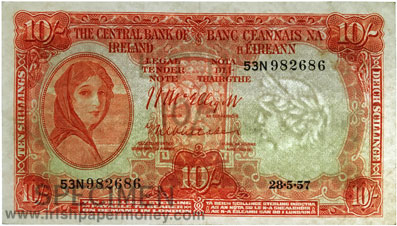

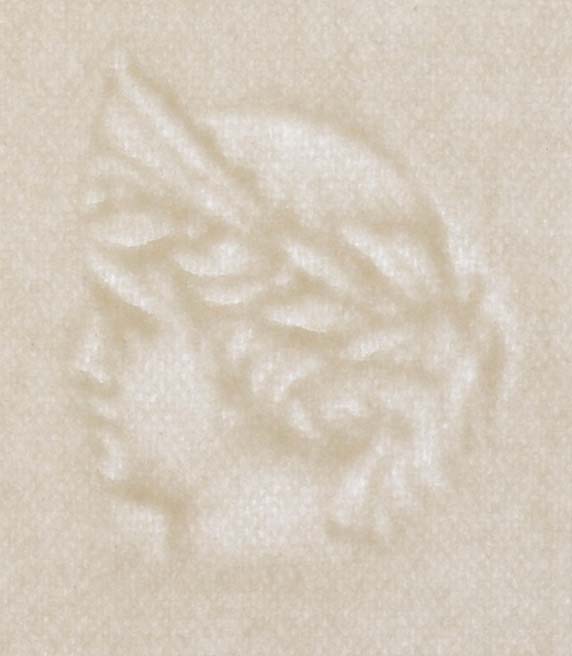
The very first Irish Lavery 10 Shilling note, number A/01 000001 was retained. It is now in the National Museum of Ireland.
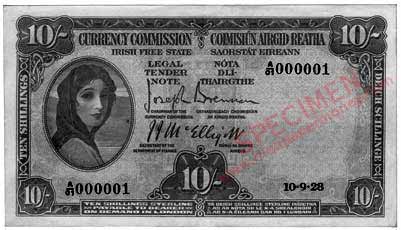
Examples of several denominations were retained by members of the Currency Commission, including some 10 Shilling notes with numbers below 000010.
Examples of Lavery low number One pound notes and Five pound notes have also survived. All known low numbers of the first issue Legal Tender Notes dated 10.9.28 are listed on the Irish Number 000001 Banknotes section, which also lists known early low numbered notes.
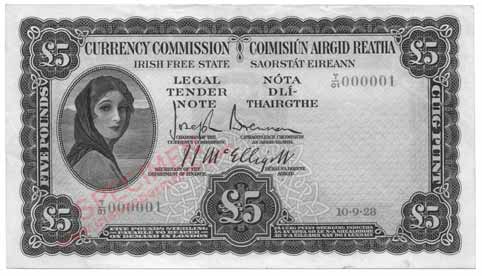
Currency Commission Ireland Specimen notes.
Central Bank of Ireland 1943 War Code Specimen notes.
Central Bank of Ireland Lavery Specimen notes - Post war notes Face and Reverse.
View by Type - Fourteen Types of Legal Tender Notes by signature and design variation.
View by Denomination - An example of each denomination for every Type.
View by Date - An image of every date for which an example has been seen of each denomination.
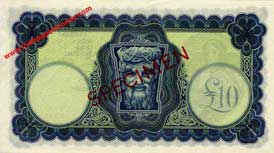
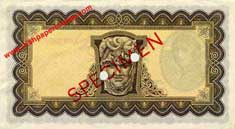
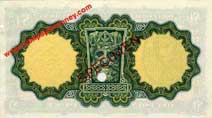
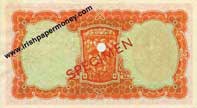
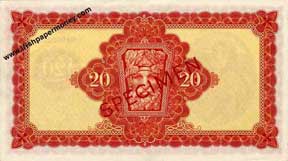
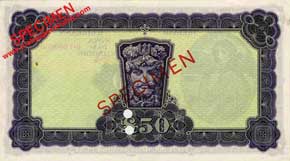

1. Moynihan, Dr M. 'Currency and Central Banking in Ireland 1922–1960', Gill & Macmillan and The Central Bank of Ireland, 1975.
2. Currency Act (1927). https://www.irishstatutebook.ie/eli/1927/act/32/enacted/en/html?q=currency+act&years=1927 [Last accessed 30.10.23].
3. Bankers (Ireland) Act 1845. <https://www.irishstatutebook.ie/eli/1845/act/37/enacted/en/print> [Last accessed 30.10.23].
![]()